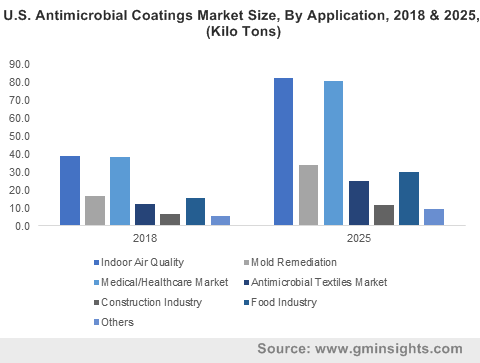Antimicrobial coatings market to garner lucrative returns via excessive product demand from the healthcare and food domains
Publisher : Fractovia | Published Date : 2018-01-19Request Sample
With rising consciousness regarding health maintenance and safety, antimicrobial coatings market has been observing an exponential growth rate, driven by the urgent necessity for preventing infections caused by harmful microorganisms. The healthcare industry has identified infectious diseases as one of the major causes of concerns in hospitals and healthcare facilities. It comes as no surprise therefore, that the growth of harmful microorganisms is a major cause of concern for the food processing and packaging industries. The rising pollution and fear of food contamination has also propelled the growth of the antimicrobial coatings industry from the construction and food and beverages industries. In essence, driven by a widespread application spectrum, antimicrobial coatings market size is likely to observe a commendable ascent over 2017-2024.
Europe Antimicrobial Coatings Market Revenue, by Application, 2013 - 2024 (USD Million)

The healthcare sector is a major growth avenue for antimicrobial coatings industry, given that the prevalence of infectious diseases has become a global concern. The European Center for Disease Prevention and Control estimates that roughly 4 million people contract healthcare associated infections (HCAI) and almost 37,000 people die annually as a direct result of these infections. Healthcare associated infections have proven to be a major challenge for healthcare units across the world – in fact, they are considered the sixth leading cause of death in western countries and have been ranked even higher in developing countries. In this regard, it is prudent to note that antimicrobial coatings prove to be a major savior for healthcare facilities and hospitals with their capability to prevent the spread of infections. The basic principle of maintaining healthy environment in a hospital is cleaning, proper use of disinfectants and maintaining hand hygiene. Yet it has been observed that many of the frequently touched and near patient surfaces are not regularly cleaned, thus facilitating the spread of healthcare associated infections. Coating such surfaces with antimicrobial coatings has indeed eliminated the requirement of consistent cleaning, thereby propelling antimicrobial coatings market share from the healthcare space.
Antimicrobial coatings industry in association to the healthcare industry also found new potential in nanoparticles of metals like silver, zinc and copper, due to their superior biocidal properties and capabilities. Silver nanoparticles have come to be widely used as an additive in healthcare fabrics like bedsheets, privacy curtains, face masks and other textiles related to healthcare. They are also used in bandages and wound dressings besides being used in intravenous catheters. In fact, antimicrobial coatings market generated significant revenue from the use of silver in antimicrobial powder coatings which accounted for 50% of the total antimicrobial coatings industry revenue in 2015. It is estimated that the silver antimicrobial coatings market will generate revenue of over $2 billion by 2024.
The F&B sector has also emerged to be a major avenue for antimicrobial coatings industry, given that these coatings are extensively used for the preservation of certain foods. Antimicrobial food packaging has also proven to be a potential alternative to traditional packaging when it comes to the protection of perishable food items – these coatings increase shelf life and protect food by preventing bacterial growth, thereby increasing the scope of antimicrobial coatings industry. It is imperative to mention that edible coatings are also becoming commonplace in the food industry, since these are enriched with antimicrobial agents that control gas exchange and slow down the oxidation process, further expanding the outlook of antimicrobial coatings industry.
With the advent of these coatings, traditional preservation methods that involved heating, acidification or salting of perishable food to prevent the growth of pathogenic microorganisms have taken a backseat. Since these coatings prevent food spoilage without compromising on the organoleptic and nutritional value, they are increasingly being preferred, propelling antimicrobial coatings market size. It is thus evident that the packaged food industry will be providing a major stimulus to the antimicrobial coatings market over 2017-2024.
Antimicrobial coatings industry still has potential avenues of growth that have remained unexplored. On these grounds, major industry players are conducting research and development programs to capture the full potential of antimicrobial coatings market. Stringent regulations have been placed on antimicrobial coatings that contain cancer-causing volatile organic compounds (VOCs), making antimicrobial coatings market quite regulatory-driven. In this regard, many antimicrobial coatings industry firms are developing products that are higher in biocidal activity but lower in VOCs. Appreciative initiatives such as the aforementioned, in addition to the prevalence of numerous R&D programs are certain to impel antimicrobial coatings market in the ensuing years.